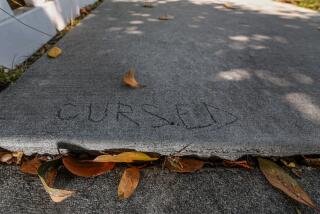An Alternative to Barren Parkways
Because the dog has the run of the back yard, Larry and Georgie Musselman moved the vegetable garden to a most unusual locale--the parkway, that little sliver of land between sidewalk and street.
“The first question everyone asks us is if any of the vegetables get taken,” Larry Musselman said. But only once has anything disappeared, when someone made off with a bushel of artichokes.
The harvests, on the other hand, have been outstanding, including such wonders as a 9-pound beet and jars full of canned beans and berry preserves. Right now, red-leaf lettuce, string beans and onions occupy one parkway bed, while strawberries and artichokes command another.
“I can’t understand why anyone would look any farther than strawberries for the perfect ground cover,” Musselman said, and, indeed, they are the perfect ground cover in his parkway--neat and quite thorough at covering the ground.
I wondered about dogs, but Musselman said people recognize it as a vegetable garden and keep their dogs at bay. “They also wonder if the city is going to come by some day and make us stop,” he said.
I hope not. The parkways under cultivation aren’t where people would normally step, because the house is on a corner and the curbs are painted red. But just what can you do with a parkway?
Most people let the parkway be a continuation of the front lawn, but it is difficult to water a lawn in a parkway because sprinklers don’t make a rectangular pattern of spray. Even those that are advertised as doing so don’t, in my experience, and a good portion of the water intended for the lawn ends up rushing down the gutter.
Parkways, as the name implies, are intended to give streets a park-like atmosphere. Trees are supposed to grow in them, but many parkways were never planted and some trees have been removed because so few trees will grow in that narrow strip of land without their roots heaving up the sidewalks or the street. A disfigured sidewalk may delight skateboarders who find every bump a ramp from which to become airborne, but others complain, and soon the parkways are simply strips of half-baked grass.
In the July 30, 1978, issue of the Los Angeles Times Home Magazine, we looked at some other possibilities for parkways, asking noted landscape architects for suggestions. Most included some paving--usually some material already used in the front yard--but suggested plants other than lawn for covering the ground.
The list of potential plants included the bronze-leaved Ajuga reptans , chamomile ( Chamaemelum nobile ), crane’s bill ( Erodium chamaedryoides ), wild strawberry ( Fragaria chiloensis ), gazania, creeping mint ( Mentha requinii ), lippia ( Phyla nodiflora ), Potentilla verna and creeping thyme ( Thymus serpyllum ). All are low-growing ground covers that are easy to water but certainly not as easy as grass to keep presentable, but then some flower and some (mint and thyme) smell good when stepped on. Most plans also suggested a few low-growing shrubs for variety.
This article also pointed out that most parkways actually belong to the city, even though the homeowner or tenant is liable for them and is expected to maintain them. However, the city does have the final say on just what you can do there, though most cities are pretty lenient if whatever you do does not pose a danger. In many cities, you must obtain a permit before doing any work on the parkway.
Perhaps the best reason for planting something other than lawn is to save water, and in the May issue of Sunset magazine, in an article on water conservation, are several additional suggestions, including planting nothing at all. The suggested gravel or bark coverings are likely to be messy, and they make skateboarding or bicycle riding downright hazardous, because these materials are often on the sidewalk instead of in the parkway. Somehow, I think they also miss the point of having an island of green.
Matsui Yellow gazanias are mentioned twice, which is quite a recommendation, and lippia is mentioned again. For small shrubs, they suggest Coprosma kirkii , Petite oleanders and “Enchantress” raphiolepsis, though all of these will outgrow most parking strips in time and will have to be edged back.
That pretty much leaves you with lawn, a few tough little ground covers or maybe vegetables. Lawns are the easiest of this lot, perhaps the most neighborly and perhaps the most aesthetically pleasing, because they tend to give the street a cohesive appearance. Grass-filled parkways make a street look like an avenue, especially when the avenue is also lined with trees, though the trees aren’t going to help the lawn thrive. Now someone has to think of a better way of watering this awkward rectangle of lawn.
As far as the City of Los Angeles is concerned, there are no hard-and-fast rules, other than whatever grows in the parkway should not obstruct the vision from automobiles, as near a curve or intersection, nor should the plants grow out onto the sidewalk where they might trip someone.
Trees are another matter and only a selected few are allowed. The other plantings shouldn’t keep anyone from opening their car door but, after that, the Bureau of Engineering suggests using just common sense when deciding what to do. I think that means that the Musselmans are safe.
More to Read
Sign up for Essential California
The most important California stories and recommendations in your inbox every morning.
You may occasionally receive promotional content from the Los Angeles Times.










